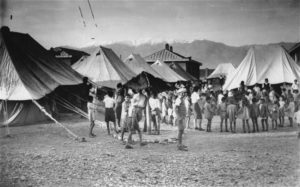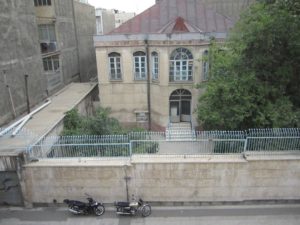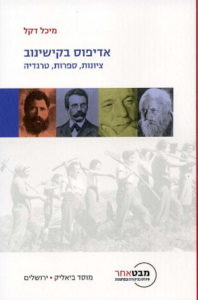Selected Articles
Between Hostility and Intimacy
Christian and Jewish Polish Citizens in the USSR, Iran, and Palestine
Polin Studies In Polish Jewry, Volume Thirty-Five, 2023
Roughly one and a half million Polish Jewish citizens found themselves within Soviet borders early in the Second World War, whether because they escaped to the USSR or their towns fell under Soviet occupation. Of these, up to a third were exiled to labour settlements and gulags in the Soviet interior. Those who survived were released as a result of the amnesty for Polish citizens of August 1941, and by early 1942 they were mostly concentrated in the fififive Soviet republics of central Asia: Uzbekistan, Turkmenistan, Tajikistan, Kazakhstan, and Kyrgyzstan. Of these, a small minority of Jewish refugees, including members of the Anders Army—the military force of Polish exiles set up in the Soviet Union under General Władysław Anders —and several thousand civilians, were evacuated alongside Christian Poles to Iran, India, and Palestine. These Polish Jews were, as it is often said, ‘saved by their deportation’.2 Yet theirs was not exclusively a Jewish fate: they were exiled alongside ethnic Poles and other minority Polish citizens, amnestied as Polish citizens, and continued to Iran, India, and Palestine along with Christian Poles. Their ordeal, therefore, is not just a Jewish survival story, but a story of wartime relations between Jewish and Christian Polish citizens outside Nazi-occupied Poland.
 When Iran Welcomed Jewish Refugees
When Iran Welcomed Jewish Refugees
Foreign Policy Magazine, October 19, 2019
In the middle of World War II, Tehran became a haven for both Jewish and Catholic Polish refugees who were welcomed as they arrived from Soviet Central Asia.

Yom Kippur in Tehran in 1942: A story about Iran, Judaism and anti-Semitism
Op Ed in the New York Daily News, Oct 8, 2019
After the older children entered, the locals gave them little gifts and sat with them for the Kol Nidrei prayer. Then, when they noticed the younger children were absent, they sent a car to fetch them, despite the strict prohibition against driving on Yom Kippur. Everyone was already seated by the time the 5- and 6-year-olds and the toddlers walked into the synagogue. When the worshippers saw the children, they all began to weep.
This essay tells how my father and hundreds of other Jewish refugee children attended Yom Kippur services in one of Iran’s ancient synagogues – Haim Synagogue – about a month after escaping from the European Nazi occupation. Without their parents. Without speaking Persian. Sitting in their own European section in the synagogue.
Tragedy Contra Theory
Comparative Literature, Volume 67, Number 4, pp. 429-444 (2015 Duke University Press)
This essay argues that in emotionally and politically fraught terrains tragic literature may offer an embodied, affective critique of the existing political order that is more effective than theoretical-didactic critiques.
Autism & Austen: Reading Brain, Emotion and Gender Differences in Pride and Prejudice
Nineteenth Century Gender Studies 10.3 (Winter 2014)
For centuries, readers and critics have interpreted Darcy’s aloof and fastidious manner as a product of social class or personal choice. But reading those passages today, with our heightened awareness of the spectrum of neurological difference, a different reading is possible.
Post Trauma Versus Inter Trauma in the U.S. and Israel
Annals of Depression and Anxiety (November 12, 2014) (with Sharon Dekel)
The question of whether prior traumatic events increase post-traumatic distress or bring about habituation to living with trauma in the general population remains unresolved. We address this question by comparing and contrasting the psychological impact of a singular trauma – the World Trade Center attacks in the United States – with that of continual trauma- the scores of suicide bombings that took place in Israel during the second Intifada.
Tehran Kids
The Global and the Intimate: Feminism in Our Time (Columbia University Press, 2012)
An introduction to my book in progress, a memoir of my search after a group of Polish Jewish children who fled Nazi occupied Poland via Russia, Uzbekistan, and Iran, ultimately reaching British controlled Palestine.
Erasing Race: The Redemptive National Narrative of S. Y. Agnon
Cambridge Review 7 (2013)
A discussion of Agnon’s analysis of nationhood as a means to erasing racial difference. The essay compares between works by Agnon and Zora Neale Hurston.
Citizenship and Sacrifice: Moshe Shamir’s He Walked Through The Fields
Jewish Social Studies18:3 (Spring/Summer 2012)
Analysis of citizenship and sacrifice in Moshe Shamir’s canonical novel-turned-play He Walked Through the Fields (1947).
Arguing that the underlying aesthetic, emotional, and political sensibility of the play is “tragic” in the classical sense, the article demonstrates how this tragic sensibility served to both portray and mask the fundamental contradictions of citizenship in the immediate post-statehood era.
‘From Where Have I Eaten My Poetry’: on Bialik and the Maternal
Shofar 31:1 (2012)
The article is an analysis of the relationship between eating and writing in Hayyim Nahman Bialik’s Bialik’s poetry. Using Melanie Klein’s psychoanalytic theory of ambivalence towards maternal feeding, it argues that such ambivalence is the basis of the poet’s identification with the national project.
‘Who Taught This Foreign Woman About The Ways And Lives Of The Jews’: George Eliot And The Hebrew Renaissance
English Literary History 74:4 (Winter 2007)
This essay centers on the Hebrew translation and the reception of George Eliot’s Daniel Deronda among Hebrew readers of the late nineteenth century. It provides a historical account of the various translation stages and analyzes the character Deronda’s importance as model citizen among aspiring nationalists. It also investigates Eliot’s place, and the place of women in general, within the predominantly male nineteenth century Hebrew reading public.
 Foreign Publications
Foreign Publications
Oedipus in Kishinev
Tragedy, both as an aesthetic form and an emotional-political category, appeared in turn of the century Hebrew literature. It rose alongside and in service of the Jewish national project as a “new kind” of response to Jewish suffering, but also in parallel to the resurgence of Greek and Elizabethan tragedy in European culture at large. In Oedipus in Kishinev, Mikhal Dekel discusses tragedy and its meaning in Hebrew works by H.N. Bialik, Micah Berdycevsky, Y.H. Brenner and others.
Blog Posts
Book Review – Siri Hustvedt. The Shaking Woman
Guernica Magazine: Hero
Guernica Magazine: The Tel Aviv Spring
Guernica Magazine: Where Have All The Protesters Gone?